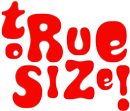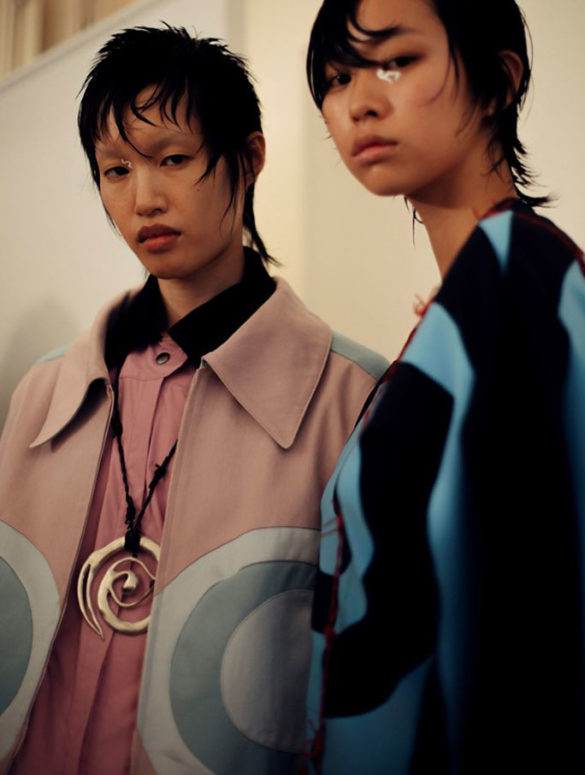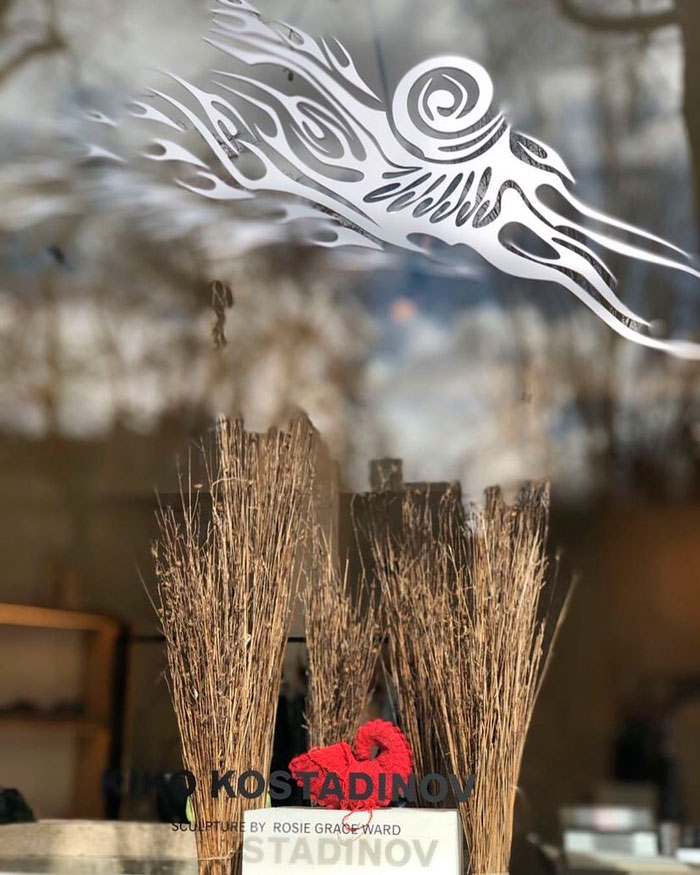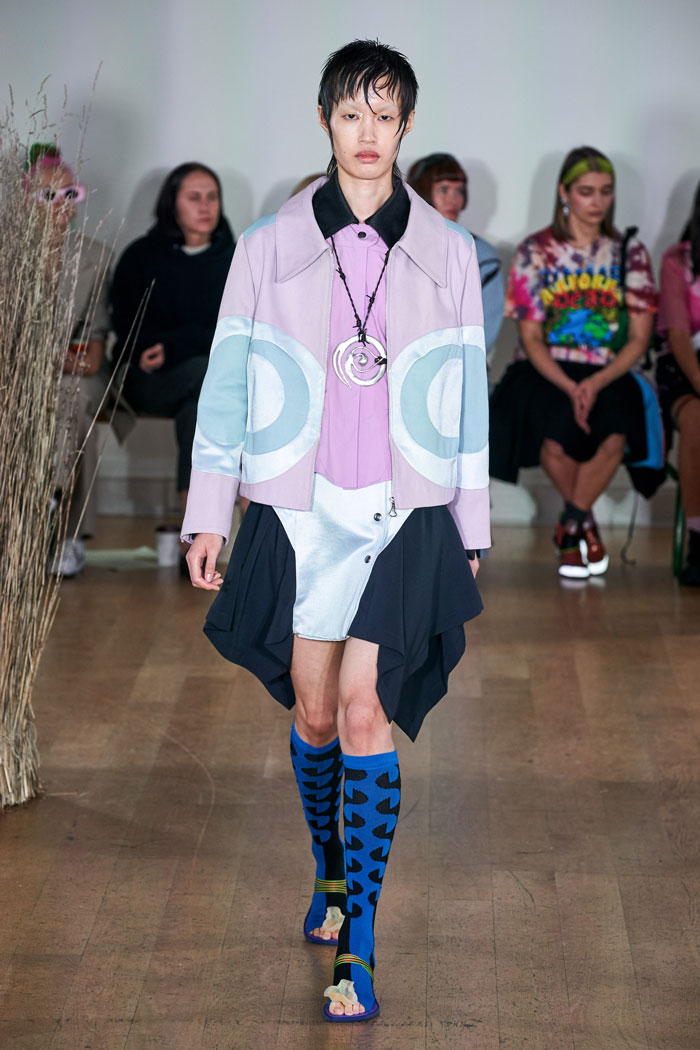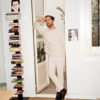Shammi exchanged emails with Rosie Grace Ward during August 2020.
All the images accompanying this email conversation have been provided by Rosie.
Nature vs nurture, meet the ‘Iron Knife Child’ artist, Rosie Grace Ward, that is combining the earthly, the religious and the cyberpunk fiction in her work, illustrating a hypotonic vision on the sinister world we live in.
Rosie Grace Ward is a sculptor, jewellery maker and writer based in London, where she graduated from Camberwell College of Arts in 2017. Ward’s gothic fantasticism vision of the world, consists of her work evolving the imagery of symbolic objects using the base materiality of mud, metal, plants and wood all forming the ‘Iron knife child’.
Largely, her work is showcased in the form of installations. She creates contexts and scenes that blend to prevale collective longing for a future to be a part of, against historical impulses towards monotonous and increasing obsolescence.
For Kiko Kostadinov SS20 womenswear collection, designers Laura and Deanna Fanning reached out to Rosie after stumbling across Ward’s sculptures at Hannah Barry Gallery, in an attempt to synergise their exploration of a cyberpunk world, creating objects of femininity in form of spirally circles, seen throughout the collection. The dystopic artist put together the set design in the show space, creating Neolithic totems which the Fanning twins used both as jewellery and as part of the garments. The sculptor helped bring to life the hypnotic circular motif that ran throughout the collection, intertwining symbols from the Chinese Yin Yang to the futuristic and folkloric.
Ward’s concerns with political warfare and obsolescence in the form of the lack of ‘progress’ in everyday life was the embodiment of her most recent work, that has been showcased on a public railway bridge on Southend High Street, commissioned by the Focal Point Gallery, ‘Arrowcut Slab (Colliding not thriving).’ Drawing inspiration from Southend’s Anglo-Saxon history, each panel – decorative, and figurative – delineate both sides of an intricately carved slab of stone. Digitalised images have been created from Ward’s hand painted watercolours, which heavily testify a fusion of Celtic stone tomb, depicted through monolithic medieval drawings and manuscripts.
Here, I speak to Ward about her futuristic vision of dystopia, her collaboration with Kiko Kostadinov and how she draws upon connections between culture and materialism.
Shammi Popat
Rosie Grace Ward
Could you just give me an outline of what you specialise in, your background and your development as an artist? Many industry experts describe you as an ‘environmental apocalyptic artist‘.
‘Enviromental apocalyptic artist’ makes me sound a bit eco fascist I promise I am not arguing for the end of the world or destruction of humanity!
I make sculptures and installations and jewellery, and I sometimes write a bit of fiction. I went to Camberwell where I didn’t really learn very much but was recommended some good books by friends like 24/7 by Jonathan Crary and Capitalist Realism by Mark Fisher, that really put into words the stasis and ennui precarity and depression that was viscerally recognisable all around me in ‘post’ austerity Britain. That time, around 2016 was so dry ideologically, and everything was obfuscated, and I had felt like I had no grip on why things were the way they were. That kind of reading helped me to draw connections between culture and materialism, and I channelled all that confusion and contradiction into my work. I got really interested in Hauntology and the culture of nostalgia FOR culture, mostly through Fisher’s writing.
It’s always hard to try and tie up the end of these sort of answers in a bow because there is no final reason that my work exists, I feel like I am just following my nose, but I suppose those moments that I have described are the formative ones.
Living and working in somewhere as space starved as London, it was an unbelievable privilege to make the things I was thinking about, and also allowed me to take on the first few shows that came up post-graduation.
In 2017 you were awarded the Vanguard Prize, of Camberwell College of Arts. How much did this aid your growth having a free studio residency at Vanguard Court for one year, with mentoring and support from Camberwell College of Arts?
It was the only thing that made it possible to be honest. I felt and still feel guilty to have won it because it such a transformational opportunity. Living and working in somewhere as space starved as London, it was an unbelievable privilege to make the things I was thinking about, and also allowed me to take on the first few shows that came up post-graduation.
It was really daunting to have this amazing space and trying to find time to use it whilst juggling part time jobs. Knowing I wouldn’t be able to be there very often made me anxious but I shared it with a friend who I graduated with who also made large scale work, so I felt like it was being used as much as possible. By the end of the residency it was overflowing with work (mostly from my prolific friend). There was clay cherubs’ heads littered everywhere, full scale angels’ wings, towers of mdf, buckets of fake blood and bundles of swords.
I didn’t really get any mentoring from Camberwell during that times, but I did get to do a show in their gallery called Think and Pray for Me. I also had continued support and mentoring from my studio mate Fred Hunt, and other friends and colleagues which was and continues to be a huge blessing.
You collaborated with Laura and Deanna Fanning for Kiko Kostadinov womenswear SS20 collection. Could you speak to me about the inspiration around this collaboration, that perfectly synergised your exploration of a ‘cyberpunk tribal world’?
So, Laura and Deanna had been to one of my shows and had got in contact with me afterwards. The twins and Kiko are really seriously interested in art so it was really exciting when they asked to work with me. We had the perfect balance where they trusted me to have full creative control of the design of the set but also, we could bounce off each other’s research really well.
When we first met it was clear to me that we had really similar research and politics. We are both interested in futurity and progress and there were obvious similarities in our work. Laura and Deanna’s designs have this totally other worldly quality about them; they reference the futurism of the 60’s, but completely diverge from the technology focussed vision popular at that time, and instead they centre the natural world, where we sit in it, and the intense spirituality and dependency of this relationship. Both our interests in the future are based on synchronicity, not supremacy, which I think is reflected in their designs. There was also a strong and coincidental link where Laura and Deanna and I had all been working on similar samples of a swirling human-like figure, which became a main motif in the show.
The twins and Kiko are really seriously interested in art so it was really exciting when they asked to work with me.
How did you approach the collaboration with Kiko Kostadinov? Was it a different approach than a regular project?
The collaborative element for this project was an intense intersection of interests. We had meetings where we discussed our ideas and research but also, we were able to work independently, with the knowledge that the end results would sit in harmony with each other. Of course, I kept them up to stay with my progress, but they never told me not to do something, or tried to steer me in a different direction. In that was it wasn’t too different from my normal approach to my work. I am very grateful to them for trusting me to do my thing. It was a risk, and i didn’t help by making 2,5 metre columns that weighed a tonne and has tiny shards of jagged metal attached to it.
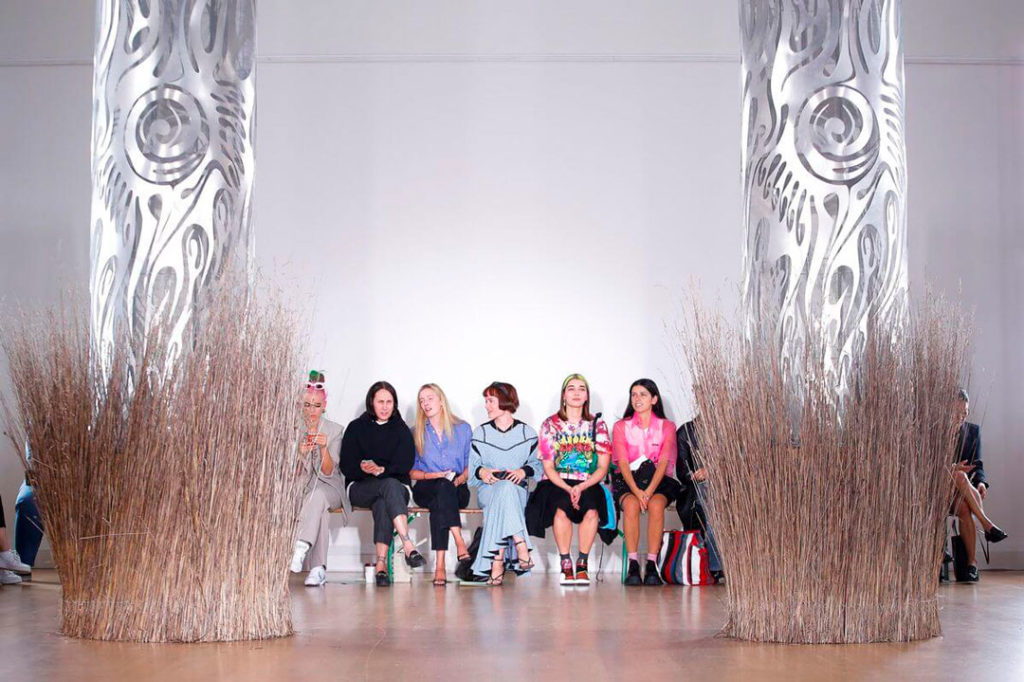
What are some of your favourite pieces from the collaboration?
My favourite Kiko pieces from that show were the Corno bag, it’s just beautifully crafted and it’s both whimsical and sharp somehow.
I was also really excited when they combined 2 pieces of the jewellery with one dress and one top in the show, where the pieces rested on the model’s clavicles. We had only spoken about the pieces being pendants, and they kept the idea a secret until I was sitting watching the show, and my jaw just dropped when I saw it. It was such a great moment, it looked so beautiful.
The pieces of jewellery for the Kiko show were part of my practice. It’s the only jewellery I’ve ever made, and they were primarily designed as cultish props.
In terms of your jewellery work, what’s the connection between this and your other work?
The pieces of jewellery for the Kiko show were part of my practice. It’s the only jewellery I’ve ever made, and they were primarily designed as cultish props. I only really started describing them as jewellery because it was easier. A lot of my work is making imagined artefacts that carry a heavy symbolic weight to them. These pieces were just an extension of that.
Can you talk us through some of your design processes in the form of manufacturing your work?
It’s a bit all over the place. Manufacturing sounds a bit grandiose for my level of organisation. I get bored quickly and I like working with new materials and processes. Because I spend so much time researching, reading and drawing, the making stage can be quite therapeutic and revitalises me although I do physically exhaust myself.
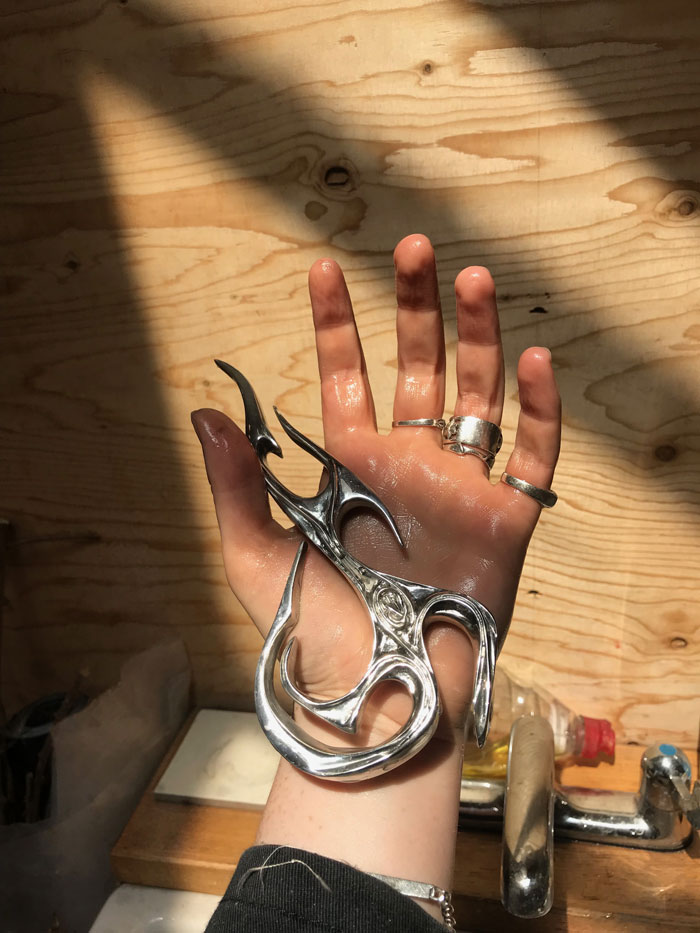
My process and use of materials are a hybrid of sort of knowing what I am doing, and also having no idea what I’m doing. I don’t have a specialism, although I do know how to work with some processes to a professional level such a mould making, and I also picked up loads of information and techniques whilst working at the old sculpture materials shop, Tiranti.
Other processes I just have to learn from scratch. It is not very balanced or organised but it does result in some happy accidents.
How have you found this global pandemic and how has it affected projects you are currently working on as a freelance artist?
The pandemic has split me in 2 in its contradictions. Firstly, it’s been horrific to watch a completely preventable disaster be unleashed in real time, disproportionally effecting the most vulnerable people in our society. This pandemic comes along and basically confirms all the failures of financialisation and capitalism that we already knew to be true, and makes an iron clad case for socialism mere months after it had been roundly rejected at the ballot box. It has made me so angry and I am totally contemptuous of everyone in the political and pundit class who failed to support a mild social democratic programme when they could, and I am infuriated with the tiptoeing wet paper towel approach of holding the government to account that passes as opposition right now. It will continue to create a gasping chasm of inequality in the arts which we will see play out for years to come.
You see the immediate effect already, with Tate workers striking after 300 jobs being cut despite them being given a government bailout of £7 million. Many of these workers will be artists, which the Tate will be well aware of. It helps to know, at least, that these institutions hold their future cash cows, artists, who they will eventually try to profit off, in complete contempt, and I hope they will never be allowed to forget it.
The flip side of all this shit is the quiet and the tedium of the slowing down of life which has been a relief. Having the opportunity to isolate myself has given me the time to focus on working with anxiety. I moved back in with my parents 2 years ago after finding working in London too stressful and precarious. I am incredibly grateful that the pandemic hit whilst I was here, as I have been around my family, in the countryside. Although all my shows were pushed back, none were cancelled which has been a great relief, although I am aware that I am in a small minority.
In terms of my routine, at the moment I am still in the research stage of a project, which I find hard to manage. Whole days get sucked out of me and sometimes I feel like I have done nothing at all. In this time, I do a lot of reading and staring at the wall, but I think the cogs are slowly turning. When I’m in the production stage of a show my schedule is much more rigorous. The job always seems to fill the time I have in which to do it, no matter how organised I am, so I will get up really early and work until 10 at night. I rarely take weekends off which is stupid and bad for you but often I find it impossible to avoid.
Having the opportunity to isolate myself has given me the time to focus on working with anxiety.
What do you currently have upcoming for the distant future?
I’m in a group show at Focal Point Gallery that opens on the 12th of September called ‘To Dream Effectively’ based on the novels of Ursula Le Guin, especially ‘The Lathe of Heaven’ which is where the title of the she comes from. It’s my first time exhibiting in the gallery itself, they put on brilliant shows and work with such great artists so I’m so excited to be included in this one, alongside so many great people.
Shammi Popat (@shammipopat) is a London-based fashion writer and stylist. He is interested in rethinking modern day style with an eye for detail and child-like curiosity for the future of fashion. Read all of Shammi’s pieces here.
